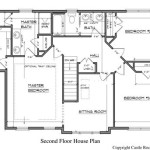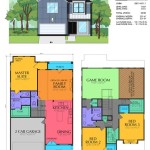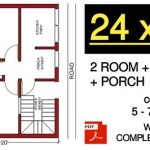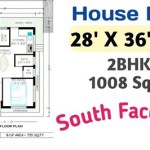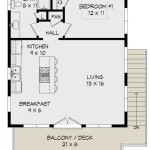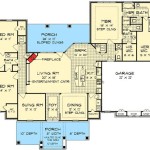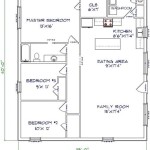Modern Contemporary House Plan Designs: Defining the Aesthetic and Exploring Key Elements
Modern contemporary house plan designs represent a significant shift in residential architecture, emphasizing clean lines, open spaces, and a strong connection with the surrounding environment. Unlike traditional architectural styles that adhere to historical precedents, contemporary designs are fluid and adaptable, constantly evolving to incorporate new technologies, materials, and lifestyle preferences. This article will delve into the defining characteristics of modern contemporary house plans, exploring the key elements that contribute to this distinct architectural aesthetic.
The term "modern contemporary" is often used interchangeably, but it's important to understand the nuance. Modern architecture, rooted in the early to mid-20th century, typically adheres to strict geometric forms, minimalism, and a focus on functionality. Contemporary architecture, however, is more encompassing, reflecting the current styles and trends. It borrows elements from modernism but also integrates postmodern, deconstructivist, and sustainable design principles. Essentially, modern contemporary design represents the current iteration of modern architectural principles, adapting them to contemporary needs and desires.
Open Floor Plans and Seamless Indoor-Outdoor Transitions
One of the hallmark features of modern contemporary house plan designs is the emphasis on open floor plans. Walls are minimized to create expansive living spaces that seamlessly connect the kitchen, dining area, and living room. This open layout promotes social interaction and creates a greater sense of spaciousness, even in smaller homes. The removal of interior walls also allows for better natural light penetration, reducing the reliance on artificial lighting and contributing to a more energy-efficient design.
This open concept is often extended further through the incorporation of large windows, sliding glass doors, and expansive outdoor living spaces. These elements blur the lines between the indoors and outdoors, creating a continuous flow between the interior and the surrounding landscape. Patios, decks, and outdoor kitchens become integral parts of the living space, offering opportunities for relaxation, entertainment, and a deeper connection with nature. The use of similar materials and design details both inside and outside further reinforces this sense of continuity.
Strategically placed windows and skylights are crucial in maximizing natural light within an open floor plan. Large windows are often oriented to capture optimal sunlight, while skylights can bring light into areas that might otherwise be dark or inaccessible. The placement and size of these openings are carefully considered to minimize glare and heat gain, contributing to a comfortable and energy-efficient living environment. The use of energy-efficient window glazing further enhances the performance of these expansive openings.
Clean Lines, Minimalist Detailing, and Geometric Forms
Modern contemporary house plan designs prioritize clean lines, minimalist detailing, and geometric forms. Ornamentation is typically kept to a minimum, with the focus on the inherent beauty of the materials and the clarity of the design. Simple, uncluttered façades are characteristic of this style, often featuring flat or low-pitched roofs, large rectangular windows, and minimal overhangs. The overall effect is one of understated elegance and refined simplicity.
The use of geometric forms is evident in the overall structure of the house, as well as in the detailing. Rectangles, squares, and triangles are common building blocks, creating a sense of order and visual harmony. These geometric forms are often juxtaposed to create dynamic and interesting compositions. For example, a rectangular volume might be intersected by a triangular roof plane, creating a visually engaging and structurally sound design.
Material selection plays a crucial role in achieving the desired minimalist aesthetic. Concrete, steel, glass, and wood are often used in their raw or minimally processed forms, showcasing their inherent textures and colors. Exposed concrete walls, steel beams, and wood ceilings are common features of modern contemporary interiors. These materials are chosen not only for their aesthetic appeal but also for their durability, sustainability, and low maintenance requirements. The careful selection and integration of these materials contribute to the overall sense of sophistication and timelessness.
Sustainable Design Principles and Energy Efficiency
Sustainability is a core principle of modern contemporary house plan designs. These designs prioritize energy efficiency, resource conservation, and environmental responsibility. Passive solar design principles, such as strategic orientation and shading, are employed to minimize heating and cooling loads. High-performance insulation, energy-efficient windows, and advanced HVAC systems are used to further reduce energy consumption. The integration of renewable energy sources, such as solar panels and geothermal systems, is also becoming increasingly common.
Water conservation is another important consideration in sustainable house design. Low-flow plumbing fixtures, rainwater harvesting systems, and drought-tolerant landscaping are used to minimize water usage. Greywater recycling systems, which reuse water from showers and sinks for irrigation, are also becoming increasingly popular. These strategies not only reduce water consumption but also help to conserve natural resources.
The selection of sustainable building materials is crucial to minimizing the environmental impact of the construction process. Recycled content materials, such as recycled concrete and steel, are often used to reduce the demand for virgin resources. Locally sourced materials are preferred to minimize transportation costs and emissions. The use of rapidly renewable materials, such as bamboo and cork, is also encouraged. Careful material selection not only reduces the environmental footprint of the building but also contributes to a healthier indoor environment.
Modern contemporary house plan designs also often incorporate features that promote indoor environmental quality. Natural ventilation, ample daylighting, and the use of low-VOC (volatile organic compound) materials help to create a healthier and more comfortable living environment. The integration of indoor plants can further improve air quality and create a more biophilic design, connecting residents with nature. These elements contribute to a holistic approach to sustainability that prioritizes the well-being of both the environment and the occupants.
The adaptability of modern contemporary house plan designs allows for a wide range of interpretations, reflecting the unique needs and preferences of the homeowner. While the core principles of clean lines, open spaces, and sustainability remain consistent, the specific details and finishes can be tailored to create a personalized and distinctive living environment. This flexibility makes modern contemporary design a popular choice for those seeking a home that is both stylish and functional.
Furthermore, advancements in building technology continue to shape modern contemporary house plan designs. Smart home automation systems, for example, are increasingly integrated into these homes, allowing for greater control over lighting, temperature, security, and entertainment. These systems can enhance energy efficiency, improve security, and simplify daily tasks. The integration of these technologies requires careful planning and coordination, but the benefits are significant.
Modular construction techniques are also gaining popularity in modern contemporary house plan designs. Modular homes are built in factories and then assembled on site, offering a faster and more efficient construction process. These homes can be customized to meet specific design requirements and often offer a lower cost per square foot compared to traditional construction methods. Modular construction also reduces construction waste and minimizes disruption to the surrounding environment.
In conclusion, modern contemporary house plan designs represent a compelling synthesis of architectural innovation, sustainable practices, and contemporary living. The emphasis on open spaces, clean lines, and a strong connection with nature creates a living environment that is both aesthetically pleasing and functionally efficient. The adaptability of this design style allows for a wide range of interpretations, ensuring that each home is a unique reflection of the homeowner's individual preferences and lifestyle. As technology and design trends continue to evolve, modern contemporary house plan designs will undoubtedly continue to push the boundaries of residential architecture.

Contemporary House Plans Modern Home The Designers

Contemporary House Plans Modern Home The Designers

Plan 44207 Modern Prairie House With 2499 Sq Ft 4 Bedroom

Contemporary House Plans Modern Home The Designers

Contemporary House Plans Modern Home The Designers

Contemporary House Design Kerala Model Home Plans

House Floor Plans Your Best Guide To Home Layout Ideas

Contemporary House Plans Modern Home The Designers

Modern House Plans Floor Designs The Designers

Contemporary House Plans Modern Home The Designers


